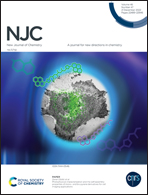A turn-on bis-BODIPY chemosensor for copper recognition based on the in situ generation of a benzimidazole–triazole receptor and its applications in bioimaging†
Abstract
A highly sensitive and selective off–on bis-BODIPY fluorescent sensor, BODIPY-NN, could be used to detect Cu2+ ions in aqueous solutions and to image intracellular Cu2+ ions in living cells. Upon addition of Cu2+ ions, BODIPY-NN showed a turn-on fluorescence response with 4-fold enhancement at 529 nm, indicating the inhibition of photo-induced electron transfer (PET) from the phenylenediamine–triazole unit to the BODIPY skeleton. This was triggered by oxidative C–N cyclization of phenylenediamine–triazole to in situ form a benzimidazole–triazole receptor providing an appropriate coordination environment that enhances metal ion binding efficiency. A mechanistic study revealed that Cu2+ acts as both a catalyst for oxidative C–N cyclization and a coordination center. The detection limit was determined to be 85 nM. Importantly, BODIPY-NN has been successfully utilized for fluorescence imaging of Cu2+ ions in MCF-7 cells and showed no toxicity toward MCF-7 cells. The non-cytotoxic nature and high sensitivity of BODIPY-NN pave a way for its use in in vivo studies as a promising fluorescent probe for high-performance sensing and bioimaging.



 Please wait while we load your content...
Please wait while we load your content...